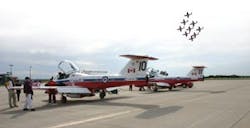A Canadian Icon
The Snowbirds Demonstration Team (431 Squadron) is a Canadian icon comprising approximately 85 serving members of the Canadian Forces, each of whom brings years of military experience to the team. The Snowbirds operate as a team at all times, both in the air and on the ground. Pilots and technicians work closely with one another on a daily basis in order to bring thrilling and safe performances to the North American public. Twenty-four of the squadron members comprise the show team that travels during the show season. The show team travels across the continent in 11 CT-114 Tutor jets, nine for aerobatic performances and two as spares, flown by the team coordinators.
Where It All Began
The Snowbirds, who first performed in 1971, operated on a year-to-year basis for seven years before being established as a permanent squadron in 1978. The Canadian Forces Air Demonstration Team was then renamed 431 (Air Demonstration) Squadron.
The seed for the Snowbirds was firmly planted in 1967 with the formation of the Golden Centennaires to commemorate Canada’s centennial year. Ten Royal Canadian Air Force (RCAF) basic jet training aircraft, CT-114 Tutors, received the gold and blue paint scheme which distinguished them as the aircraft from the RCAF formation aerobatic team. However, at the end of the 1967 season, the Centennaires were disbanded, and the aircraft were returned to the training role.
Colonel O.B. Philp, the commanding officer of the Centennaires, became the base commander of CFB Moose Jaw, based in Saskatchewan, but he never forgot the team of 1967. He wanted to ensure that the traditions of aerial perfection established by teams such as the Golden Hawks and his own Golden Centennaires would not be lost. Accordingly, he established an unofficial non-aerobatic formation team in Moose Jaw in 1971. The team was made up of volunteer instructor pilots and ground crew led by Major Glen Younghusband.
All of the instructors came from Two Canadian Forces Flying Training School (2CFFTS) in Moose Jaw. The team utilized seven ex-Centennaire Tutor aircraft. Since these aircraft were already repainted white, they were readily distinguishable from the other silver-colored aircraft of the Moose Jaw fleet.
The 2CFFTS Formation Team members practiced in the evenings, after completing their primary instructional duties, and performed on weekends. The new team was named the “Snowbirds” as a result of a contest held at the Base Elementary School and first flew under this name at the 1971 Saskatchewan Homecoming Airshow.
Northern Lights Shine on the Snowbirds
In 1973 the show was expanded to include aerobatic formation maneuvers and the show season began in May with what was to become the annual “Northern Tour,” followed by shows across Canada and the United States. Funding for the team still came from the base budget and Training Command; team members were responsible for paying for half of their clothing which included the distinctive red flying suits that have become a Snowbirds trademark.
In 1974, for the first time, the tryout competition was opened to pilots from bases throughout the Canadian Forces. The team was also cleared to perform a fully aerobatic formation display. The color of the Snowbirds aircraft changed that year when the distinctive red, white and blue paint scheme, (that still exists today), was adopted. The team deployed to CFB Comox in April for a workup period designed to test deployment procedures and expose team members to new show sites with difficult terrain features. This spring training session at Comox has become an annual operation. During the Northern Tour that year, with a performance at Inuvik, the Snowbirds became the first North American formation team to fly a show north of the Arctic Circle. At the end of the season, the team had flown 80 shows with an estimated viewing audience of two million people.
In September 1977, the Snowbirds were finally made a permanent unit, and their official designation became the Canadian Forces Air Demonstration Team (CFADT) and in 1978 they received squadron status and the Snowbirds became 431 (Air Demonstration) Squadron. 431 “Iroquois” Squadron, The Hatiten Ronteriios or “Warriors of the Air,” had been a World War II Bomber squadron that was disbanded in 1945. It was reformed briefly in 1954 as an F-86 saber squadron which contributed four aircraft to the “Prairie Pacific” aerobatic teams.
The First U.S. Tour
In May, the Snowbirds ended their first US tour on a high note after a delightful few days performing at the Southern Wisconsin Airfest in Janesville, Wisconsin.
“The 2008 season took the team to 60 airshows in more than 40 different locations across North America, says Captain Jones, Snowbirds public affairs officer.
“The team has a demanding schedule, which involves more than 60,000 kilometres of transit in addition to the airshows and practices. Under the leadership of Master Corporal Jean-Marc Brien, crew chief, and Corporal Cam Simms, the deputy crew chief, the servicing technicians conduct inspections, routine maintenance as well as re-fuel the jets prior to flight.” As part of these inspections, the technicians follow a rigid checklist that includes everything from verifying fluid levels to inspecting instruments to replenishing oxygen to checking brake wear. Each servicing technician is assigned to a jet, which generates a tremendous sense of pride. Working on the ramp in all weather conditions, the servicing technicians conduct the first line maintenance in the rain, wind, snow and cold. The pilots and technicians work closely together to perform the inspiring and breathtaking show that Canadians have known for more than38 years.
